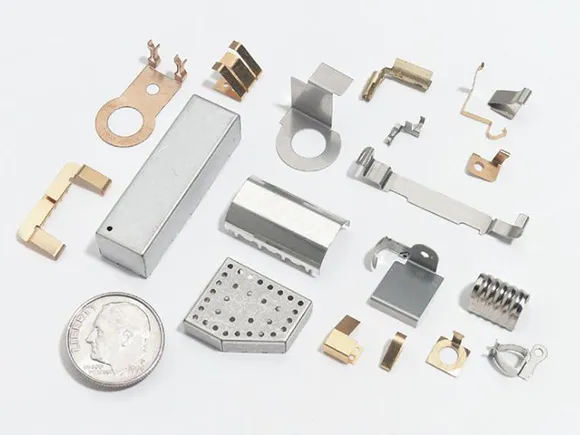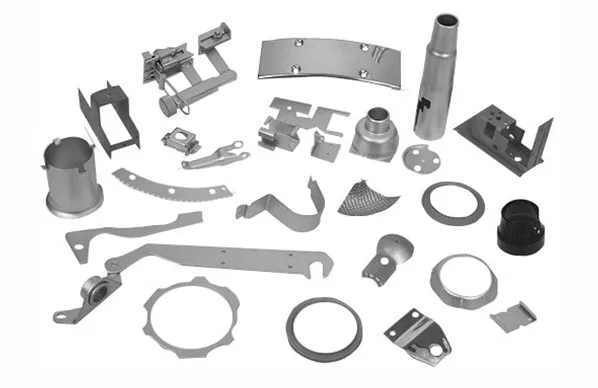Stamping is the process of placing flat sheet metal in either blank or coil form into a stamping press where a tool and die surface forms the metal into a net shape. Stamping includes a variety of sheet-metal forming manufacturing processes, such as punching using a machine press or stamping press, blanking, embossing, bending, flanging, and coining.This could be a single stage operation where every stroke of the press produces the desired form on the sheet metal part, or could occur through a series of stages. The process is usually carried out on sheet metal, but can also be used on other materials, such as polystyrene.
Sheet Metal Stamping Process
There are basically only three components to sheet metal stamping—the sheet metal, die, and press machine—but any single part can require multiple steps to arrive at its final form. The following guide explains common processes that might occur during metal stamping.
Bending
the material is deformed or bent along a straight line
Flanging
the material is bent along a curved line.
Embossing
the material is stretched into a shallow depression. Used primarily for adding decorative patterns. See also Repoussé and chasing.
Blanking
a piece is cut out of a sheet of the material, usually to make a blank for further processing.
Coining
a pattern is compressed or squeezed into the material. Traditionally used to make coins.
Drawing
the surface area of a blank is stretched into an alternate shape via controlled material flow.
Stretching
Surface area of a blank is increased by tension, with no inward movement of the blank edge. Often used to make smooth auto body parts.
Ironing
the material is squeezed and reduced in thickness along a vertical wall. Used for beverage cans and ammunition cartridge cases.
Reducing/Necking
used to gradually reduce the diameter of the open end of a vessel or tube.
Curling
deforming material into a tubular profile. Door hinges are a common example.
Hemming
folding an edge over onto itself to add thickness. The edges of automobile doors are usually hemmed.

The applications of Sheet Metal Stamping
In the stamping process, sheet metal is transformed into complex parts using highly specialized computer-aided drafting and manufacturing programs. Sheet metal stamping produces superior, resilient, heavy-duty parts quickly and efficiently. The results are so precise, they’re typically more reliable and consistent than manual vowin.cn/en/News/news1251.html' target='_blank'>machining.The following industries use components that are created via sheet metal stamping: Automotive, Renewable energy, Medical, Industrial, Aerospace, Hardware and Home Improvement.

Why choose us for Sheet Metal Stamping?
Established in 2002, Kaierwo is a professional manufacturer of customized Sheet Metal Stamping services manufacturer with its own R&D team.We are ISO9001:2015, ISO13485:2016 certified. We have a 5,000 square meter plant that allows us to complete a variety of sheet metal fabrication one-stop services. You can get products cheaper than other manufacturer and we can also provide you with free samples.
FAQ
1.How to deal with surface treatment problems?
Sample color identification and dispensing ensure batch color consistency, strengthen manual inspection, avoid the defective products.
2.What is the best pre-treatment for prepping Aluminium castings?
Sandblasting Aluminium castings prior to finish is most common. E-coating would be a great economical operation. Chemical film is another treatment. It acts as an excellent primer for wet coat finishes on Aluminium.
3.How surface finishing works?
Almost all surface finishing processes improve either the aesthetic appearance of the product or its mechanical or chemical properties. Each surface finishing process achieves this in a slightly different way.
4.How much material is removed during the Sandblasting process?
During the Sandblasting process, the surface of a part is peened off, no part material is removed or lost at all. This process is typically used to soften parting lines or eliminate any sharp edges that could impact your line workers in the assembly process. It can also be used to give a uniform finish.
5.What the benefits of surface finishes?
Improve the appearance of your finished products, Improve resistance to wear and tear, Ensure good adhesion of paint, Meet your brand requirements...


